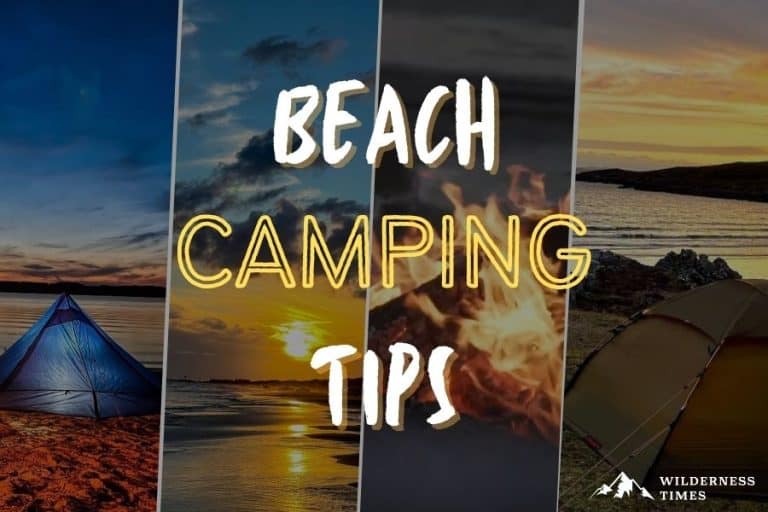Beach camping is an incredible way to enjoy the coastline.
However, it is a little different from regular camping. But that shouldn’t be an issue as long as you’re prepared!
In this article, we’ll go over some beach camping tips in this guide, so you can have the best time on your beach adventure.
How To Prepare
The key to an enjoyable camping trip is preparation. And there’s a little extra preparation when camping at the beach!
Before you hit the road to head out to the beach, here are some things you should consider:
Determine Where You Want To Camp
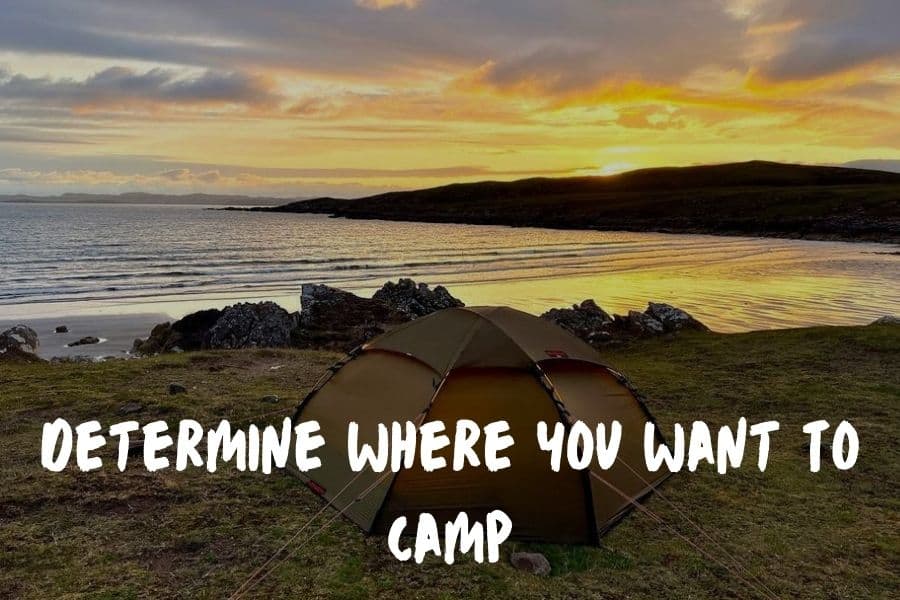
The US has a whopping 95,471 miles of shoreline, and most of it is covered in beautiful beaches.
From rocks to tropical sands, you have quite a choice to make regarding what type of beach you want to camp at.
But the first choice you need to make is deciding between designated campgrounds and dispersed camping.
Most designated beach campgrounds offer different amenities like bathroom facilities, grill areas, and drinking water.
Plus, many campgrounds are accessible by cars or RVs.
All of that is not available if you’re dispersed camping. For beach camping, that is a campsite that’s close to the ocean.
Depending on the location, you might also have fewer people around you than you’d experience at a campground.
You should know that not all coastlines allow camping on the beach, though. In the case of many public beaches, camping is illegal.
As for state park beaches, it varies depending on the location and whether or not they allow dispersed camping.
When in doubt, it’s best to contact a ranger in a specific state park to see what the regulations are.
Prep For Wet & Windy Conditions

Ocean water is cold. Even on an extremely hot day, the water can’t heat up a lot due to its large volume.
Sand and rocks, on the other hand, easily heat up once the sun rises.
Now, this uneven heating of surfaces sets up areas of different air pressure zones.
Hot air is lighter and denser than cool air, so it will rise while the latter will drop down.
This creates wind and condensation, which can make for a rainy, dreary mix.
With this in mind, it’s no wonder why ocean coasts are so breezy.
And you can definitely assume that windy weather is unavoidable on your beach camping trip.
In some areas of the country, the same goes for wet weather conditions.
This is particularly the case in Florida, where you can expect a drizzle in the summer afternoons.
My point is – it’s practically impossible to avoid wet or windy conditions during your camping trip on the beach.
But neither should kill all the fun. Just make sure to bring a rain jacket or other pieces of clothing appropriate for the weather you’ll experience.
Bring Your Own Firewood & Camp Stove

Don’t rely on collecting firewood when you’re camping at the beach.
Unless you’re surrounded by thick forests, you probably won’t find fallen branches or sticks lying around.
What you might find is driftwood, but in that case, there are a few things you should know:
First off, there are beaches that don’t allow the harvesting of driftwood, including private and state beaches.
Many smaller animals use driftwood as shelter, so you would be disrupting the ecosystem by using it.
Not just that, but driftwood is just not suitable for making fire.
Since it’s covered in salt from the ocean, it will burn hotter than regular wood and emit sodium and chlorine ions, which can form toxic compounds.
So, your only option is to bring your own wood to the beach.
When doing so, make sure you don’t actually move the wood more than 50 miles to prevent moving infectious species found on the wood.
Get Sturdy, Comfortable Hiking Shoes

When hanging out on the beach, you’ll probably be barefoot or wear flip-flops.
But if you plan on hiking along the coast, you should definitely wear proper hiking shoes.
Now, it doesn’t matter whether the beach is rocky or sandy – these shoes will provide your feet with proper support for walking over uneven terrain.
Pack Plenty Of SPF Protection

I can’t stress enough how important sun prep is. Even in the city – but it’s an absolute must when you’re on a beach.
Chances are, you’ll have very little shade available other than the beach tent, tarp or whatever you might have brought to your trip.
That means your skin will be exposed to the sun for a prolonged time.
To protect your skin from damaging sun rays, bring sunscreen. Personally, I use two – one intended for the face and one for the body.
But you can find many products that can be used on both!
What’s great about sunscreen is that you have a bunch of options available.
From thick creams and gels to sprays and sticks, you can choose whichever type of application works best for you.
When it comes to rating, SPF50+ is the best option for the beach.
That’s true no matter how light or dark your skin might be, as everyone is at risk of sun damage.
Sunscreen keeps you protected for around two hours, meaning you’ll have to reapply often.
And in case it’s not a waterproof kind, you’ll have to do the same every time you get out of the water.
I know it sounds like a lot of work. And it is. But you really need to protect your skin when you’re spending so much time in the sun.
Research The Tide Patterns
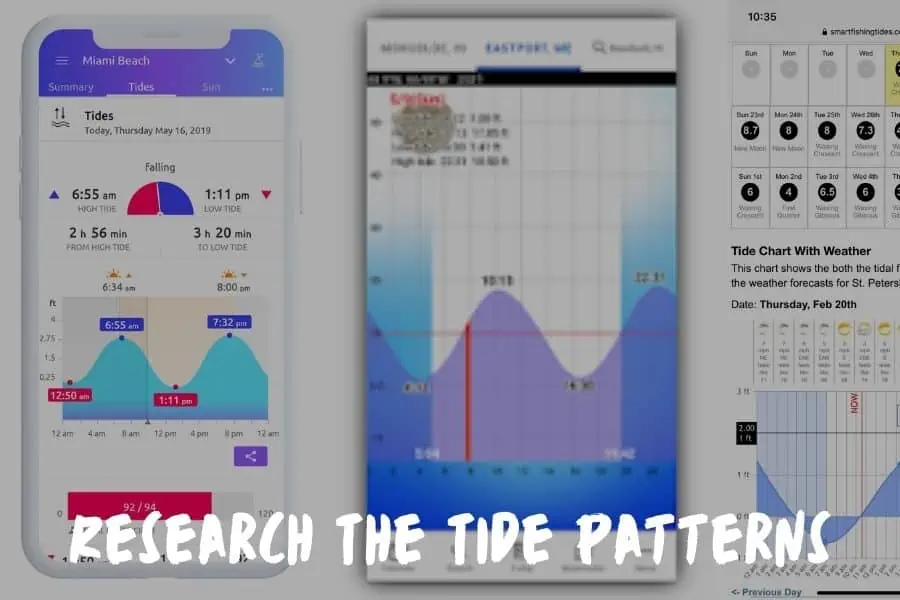
With developed campgrounds, this is not something to worry about, as they’re usually situated away from the shore.
But if you’re dispersed camping, then you should be aware of the tides when choosing a camp spot.
Keep in mind that during full and new moon stages, the fluctuation between high and low tides can be much larger.
If you’re unsure how far from the water you should set up your camp, look for washed-up debris on the beach.
Move away another 20 feet from that line, and you should be okay.
To keep an eye on the tides, you can get a tide tracker app for your phone.
These apps tell you everything from 72-hour forecasts to monthly high tide outlooks.
Follow Leave No Trace Principles
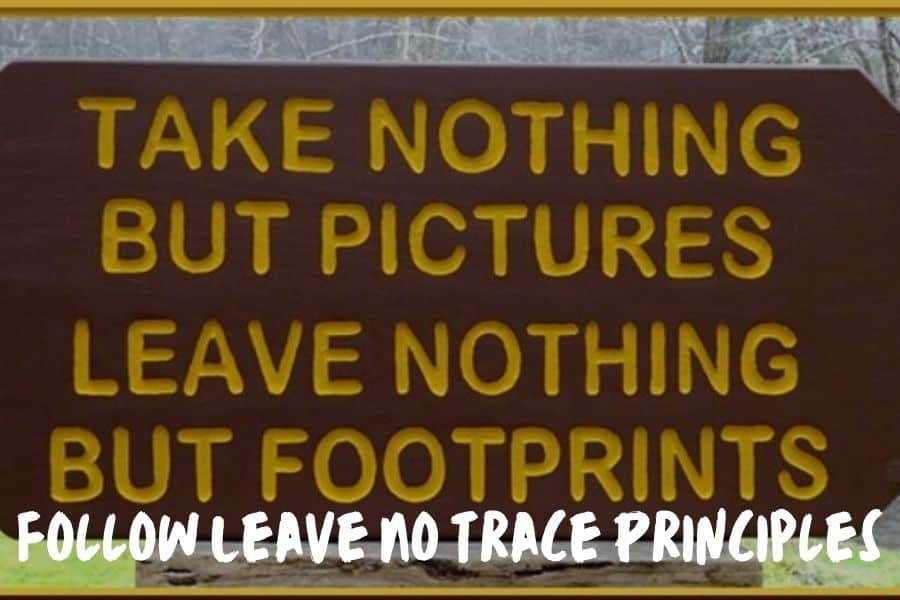
Regardless of where you’re camping, you should always follow Leave No Trace principles.
When it comes to waste, it’s imperative that you pack up everything, including food scraps.
Anything you leave behind may negatively affect the environment, including the animals living in it.
When choosing a spot to do your “business”, make sure you stay away from the dunes.
Dunes are home to many small animals and plants, so you want to keep their natural habitat intact.
You can review all of the Leave No Trace principles here!
Prioritize Hydration & Water

From the salty ocean air to the burning sun, it’s easy to get dehydrated on the beach.
If you’re camping within a campground, then you might have drinking water available on-site.
If that’s not the case, or you’re remote camping, then bring even more water than you typically would on a camping trip.
As a rule of thumb, people should drink at least 0.75 gallons of water a day.
In a hot environment, this number should be rounded up to one gallon.
Choose The Right Campsite
Don’t know where to set up camp on the beach? Well, there are a few things to keep an eye on.
Look For Signs Of Wildlife

Regardless of where you’re camping, the last thing you need at your campsite is unwanted intruders.
So, when choosing a spot, check whether there are animal tracks in the sand.
Avoid placing a tent on a burrow, as that’s probably inhabited by a crab.
The same goes for setting up a camp that’s close to a trash can.
And I’m not saying that because of the lingering smell!
You see, those trash cans will attract raccoons, which can be quite aggressive when they’re rummaging.
Check Your View

Since you’re out on the coast, you’re surrounded by beautiful scenery. So, why not get the best view possible?
I recommend looking for spots with unobstructed views. That’s not always possible
Now, that doesn’t mean you should set up on a dune.
Again, sand dunes are wildlife habitats, and you don’t want to disturb it. Not just that, but you could get fined.
Sand can be quite comfy as long as it’s not lumpy. So, try to find the most flat ground you can.
You can smooth your tent area even more by dragging a tarp or blanket across you spot.
Pro-tip: start on one end and walk backward as you smooth it so you don’t mess up the sand you already smoothed.
Check Your Campsite’s Drainage

Although this might not be such a big issue as it is when you’re camping on harsh terrain, you should still take drainage into consideration.
If the terrain (be it sand or ground) is sloping towards your campsite, rainwater could end up in your tent.
Luckily, sand is easy to manipulate, even without tools.
I recommend digging a moat or a canal around your tent to drain the water away from your tent in case it rains at night.
Choose Your Orientation

I’m sure you’re tempted to turn your tent door facing the sea. After all, you’re there for the views!
However, you should keep in mind that the breeze is usually coming from the sea.
But, facing away from the wind will keep your tent from flapping throughout the night.
Aside from the wind, you should take sunrise into consideration.
If you pitch your tent with the door pointing to the east, the sun will shine directly on it in the morning.
What a beautiful way to wake up, no? But if you’re not a morning person, it may not be the best.
Make The Most Of Sun & Shade
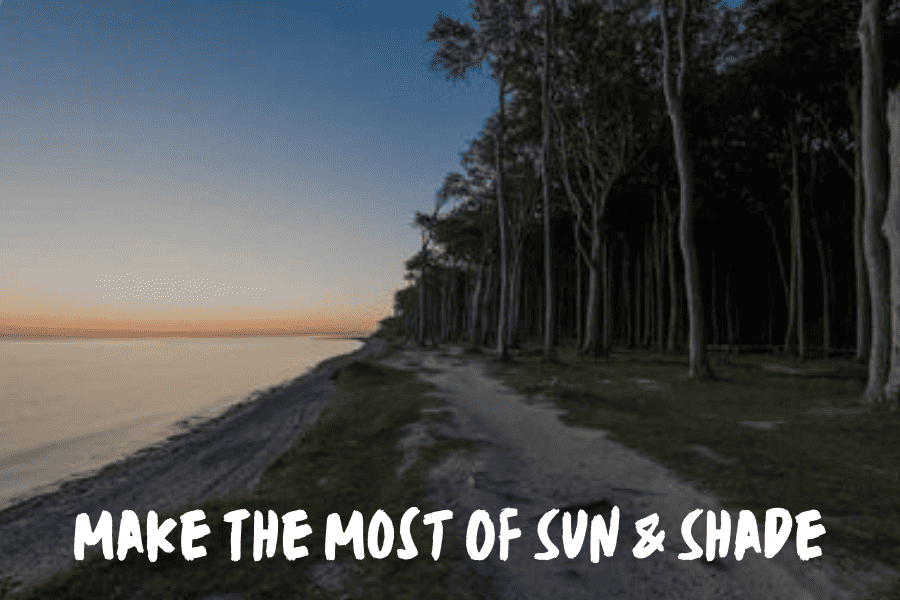
When camping on the beach, the chances are you won’t have much shade available.
But if there’s a small spot with a bit of shade, pitch your tent there!
During the hottest part of the day, having a tent covered by shade can make a huge difference in your tent’s inside temperature, especially if you like taking noon naps.
Check Your Proximity To High-Traffic Areas

No one enjoys being awakened by the sound of traffic.
That’s especially true when you’re camping – you want to enjoy nature!
When choosing a camping spot, try positioning yourself away from the road.
Of course, you should still keep the tide in mind when choosing how close to the shore you want to be.
Watch For Sharp Objects

Ah, the things that the ocean can wash ashore… Unfortunately, the list is endless.
But you should be especially aware of sharp objects – from glass and other human trash to broken shells and sharp rocks.
Obviously, putting a tent on top of sharp objects is a recipe for disaster.
Most tent floors aren’t puncture-resistant, so you could easily rip them.
Setting Up A Tent On the Beach
And now for the fun part – pitching a tent on the beach.
Given the circumstances (like soil and weather), this is somewhat more difficult than pitching a tent on regular dirt.
Have A Partner Help You
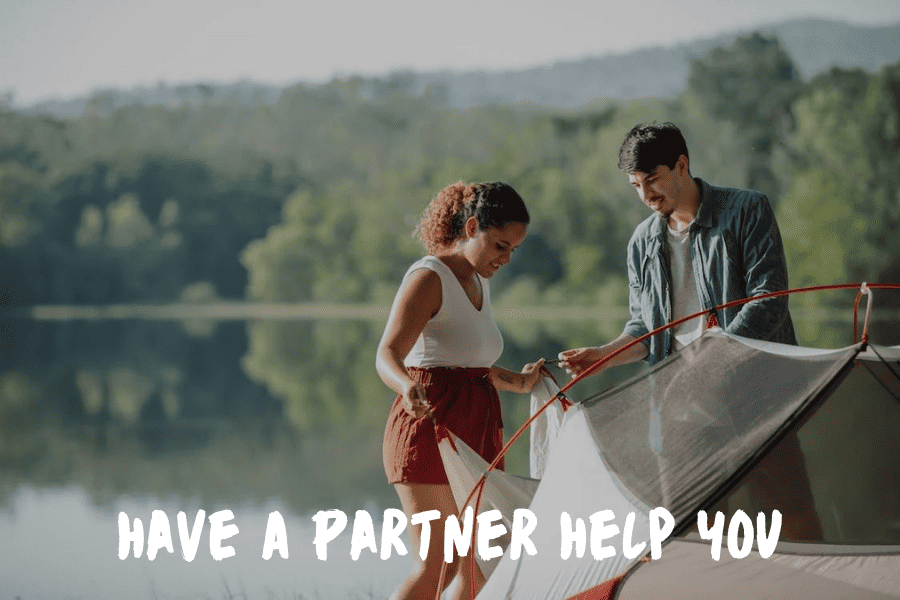
If the day is calm and wind-free, you’ll probably be able to pitch the tent yourself.
But it’s almost always breezy on the beach, so you’ll need help from your partner.
Basically, one of you should hold the poles while the other secures everything in place.
That way, the wind can’t blow the tent away before you manage to pitch it.
Use Sandbags To Weigh Your Tent Down
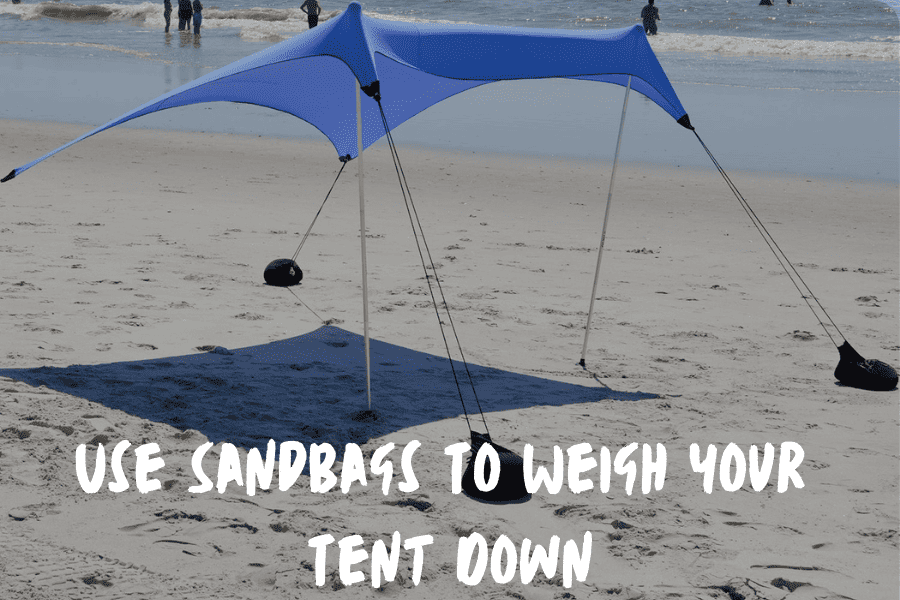
Traditional stakes won’t do much when it comes to pitching a tent on the beach.
The sand is way too loose to hold such stakes in place.
But you can get sand stakes for this specific situation. Or, you could use sandbags to weigh the tent down.
What are sandbags, you might ask? Exactly what they sound like: bags filled with sand.
Of course, you can also add stones for even more weight.
Fill the bags, then make loops with guylines on each corner you’d use a stake for.
Attach the bags to the loops, and they’ll keep the tent anchored in place.
Invest In A Pop-Up Tent
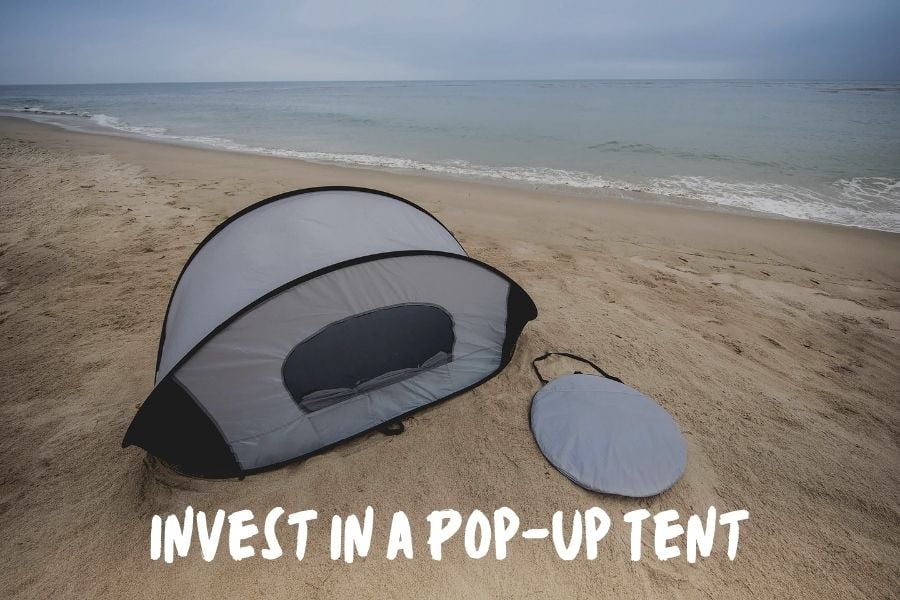
Pop-up tents are an excellent choice for beach camping.
These tents stay pitched even without proper staking, which is what makes them so great in this case.
Now, I’m not saying you shouldn’t anchor your tent to the ground, as it will fly away with the wind.
But a pop-up tent will stay taut, even when the guylines aren’t.
Read: Pop Up Tent VS Regular Tent: Which is Better?
Use Guylines To Stabilize Your Tent
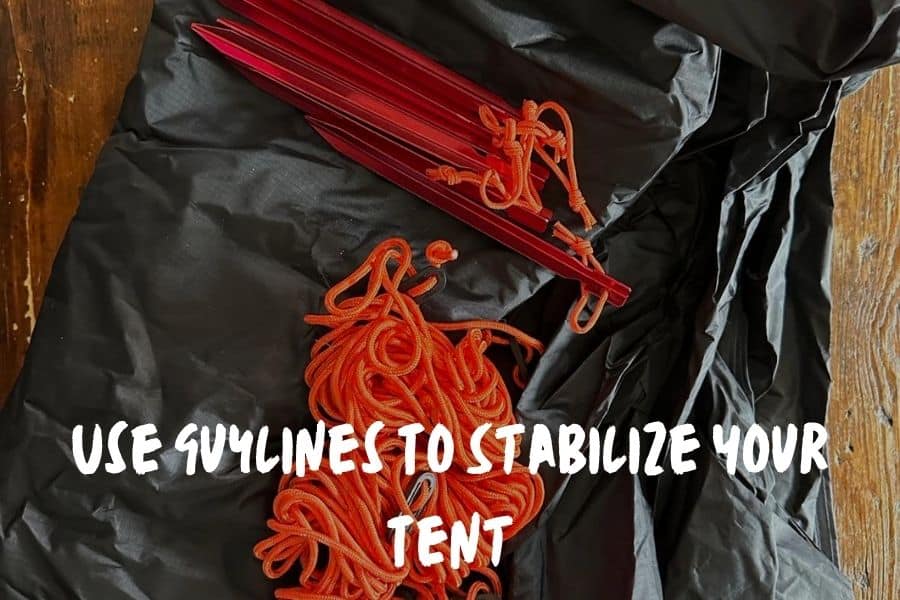
Of course, you should always go to extra lengths to stabilize your tent when camping on a beach.
Using guylines is essential to keeping your tent stabilized in the sea breeze.
Make sure the guylines are long, as you’ll be attaching rocks or sandbags to them.
Of course, quality matters. With the wind blowing, the guylines will rub against the sand, rocks, and anything else they’re in contact with.
Go with polyester, dual weave guylines if possible.
They should be at least 1.5 millimeters in width, which is perfect for beach conditions.
If they’re reflective, even better.
I know that’s not a functional feature, but it does make your job easy when you’re leaving the tent at night to go to the bathroom.
How To Stay Sand-Free While Camping On A Beach
Not going to lie – having sand stuck everywhere is never fun. But, there are a few things you can do to prevent that from happening.
Invest In A Sand-Free Beach Mat Or Create A Sand-Free Entryway
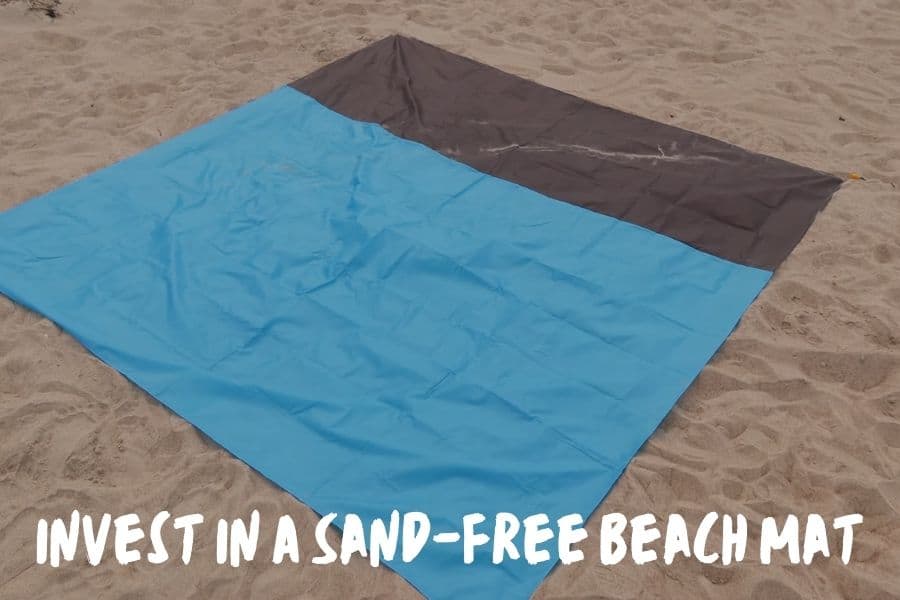
Sand-free beach mats are amazing. They’re made of multi-layered material, which allows sand to slip right through the weave.
What’s more, air passing through the mat allows it to stay in place when it’s windy.
Don’t want sand in your tent? Smaller versions of the same product exist, and they’re amazing to put in front of the tent door.
Simply take off your flip-flops and clean your feet on the mat before entering the tent.
Other Ideas
There are a few other things you can do to keep the sand away.
First and foremost, stay dry! The sand will stick to your wet body, and as it dries, it will start falling off and probably end up in your clothes and tent.
Therefore, make sure to always wipe down after having a quick swim in the ocean.
Another thing you can do is sprinkle a bit of baby powder on spots where sand is sticking to your body.
Brush the spots and you’ll be sand-free within seconds.
This is especially useful for hard-to-clean spots, like elbows and knees.
Oh, and don’t forget to keep your tent zipped up at all times! You don’t want the breeze blowing sand inside your shelter.
Essential Gear For Camping On The Beach
Aside from your regular camping gear, you’ll need to bring a few more things on your beach camping trip:
Beach Tent
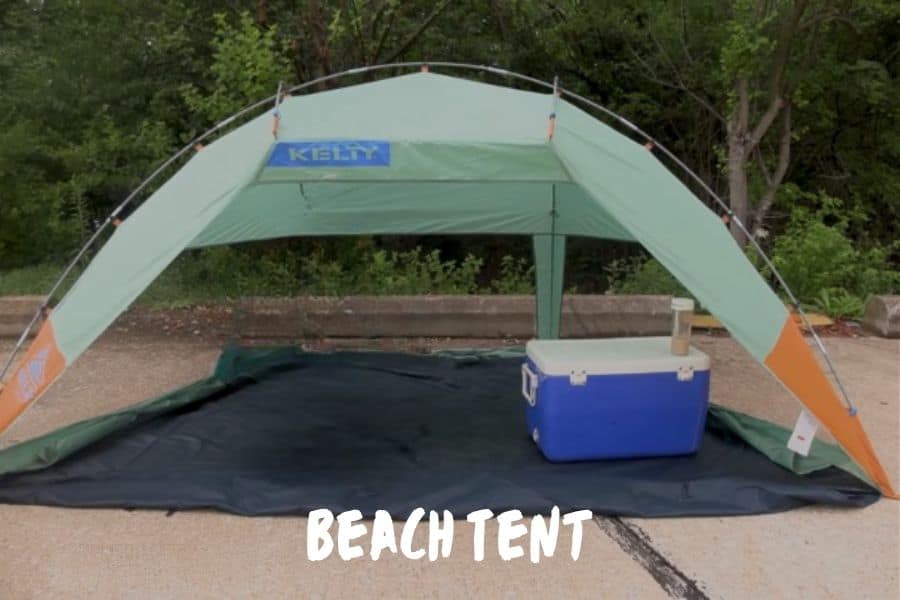
A beach tent is basically a tent with a fully opened one side.
The purpose of this tent is to create shade and wind protection while allowing you to enjoy the views.
Beach tents usually feature floors, which is great.
You can sunbathe or eat while avoiding getting sand on your skin or food.
Sleeping Bag
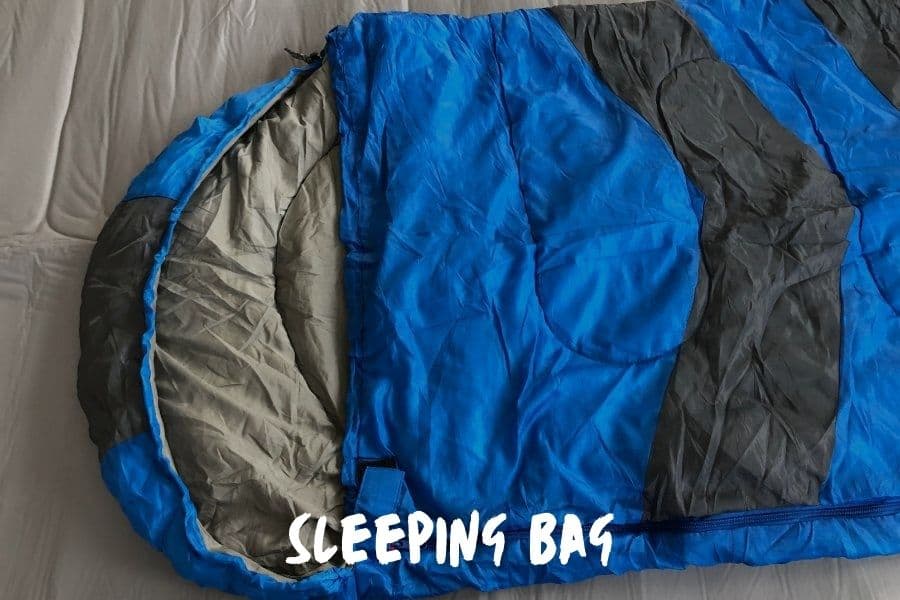
Even though the days are hot, nights can get really cold at the beach. That’s why a sleeping bag is essential.
Of course, you don’t need an ultra-warm sleeping bag.
In most cases, a 50-60 temperature rating will be ideal, but this will entirely depend on the time of year and the weather you’re expecting.
Rectangular sleeping bags are your best option, as they provide enough room to spread out if you get hot at night.
Baby Powder

Now, I would have never thought this to work, but it does.
Just let the sand and water on your body dry before rubbing baby powder on those areas.
You don’t want to end up with a weird sand-powder paste all over your body.
Sunshade For Beach Camping

The sun can be almost unbearable during those hot, steaming days.
A beach tent is okay for sitting, but what about doing other chores around the camp?
To make more shade, bring a beach umbrella or a canopy.
The latter is larger, but the former is easier to set up in loose sand.
Ripstop Adventure Blanket
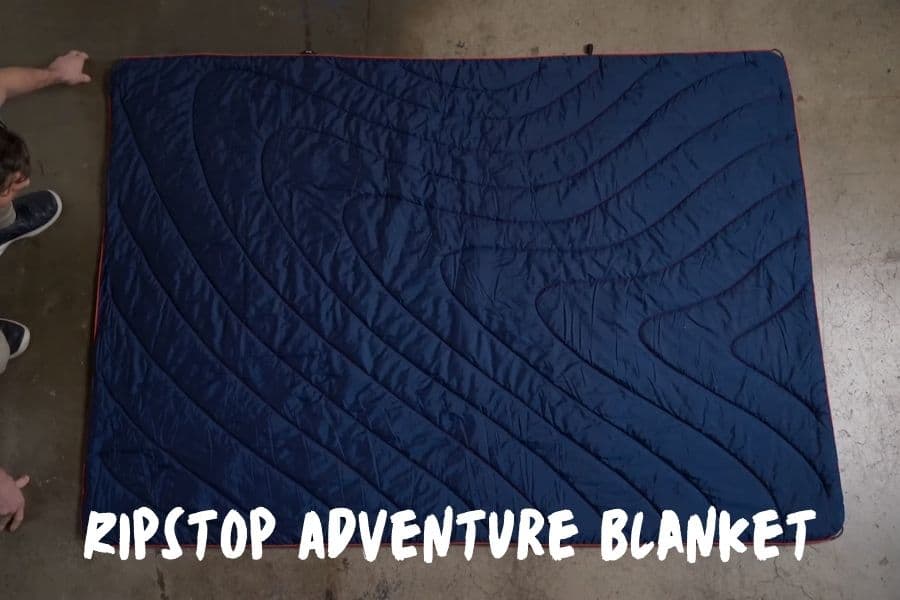
Personally, I’m a big fan of these blankets. Made of ripstop nylon, they’re rugged and waterproof, so they’re ideal for a beach.
Typically, the top side is made of microfiber, which dries down rather quickly and is comfortable to sit on.
Many of them also feature loops at the end, so that you can stake it to the ground.
This ensures the blanket stays in place when it’s windy.
Sun-Protective Clothes

Dressing up on a sunny day won’t necessarily save you from harmful UV rays.
In fact, most clothes will pass quite a lot of it through the material.
Sun-protective clothes, on the other hand, will either absorb or block harmful UV radiation.
Plus, most UV clothes look and feel like activewear, so they’ll keep you cool during a hot day.
Privacy Shelters

Letting your clothes (or swimwear) dry down on your body can get you sick.
That’s why you should always change after getting out of the water.
Of course, that’s easier said than done when you’re at the beach filled with people.
That’s where privacy shelters come into play – you can use them to change into something else.
Starting A Campfire On The Beach
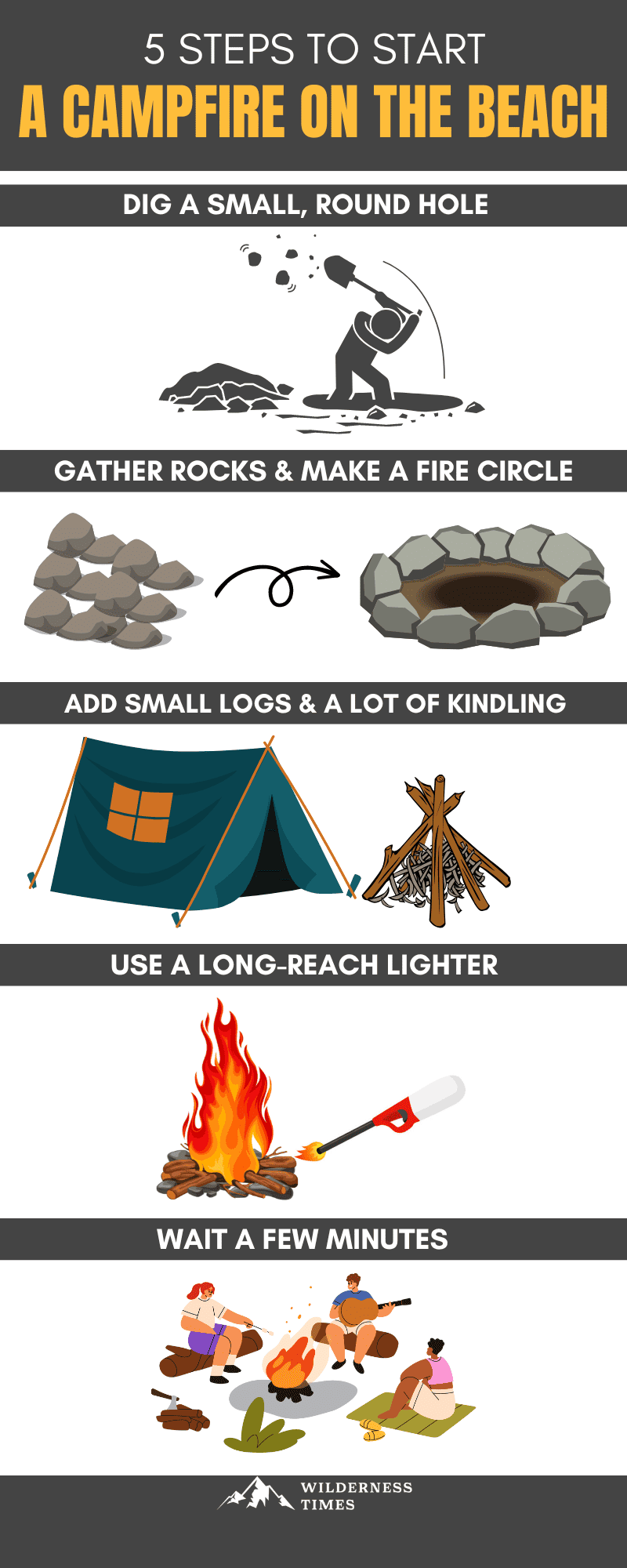
Once the night sets in, you might want to set up a campfire to warm up and make dinner.
Setting up a campfire on a beach is somewhat different from doing the deed on sturdy terrain.
Here are a few things you should do:
Dig A Small, Round Hole
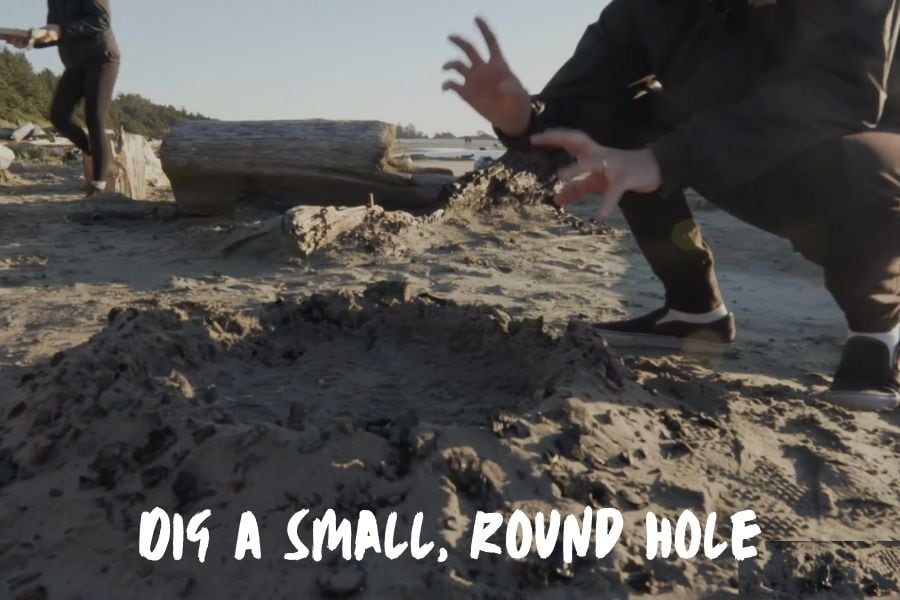
The constant breeze can make it harder to start a fire. Luckily, you can fix that by digging a small hole to create a natural windshield.
Plus, the hole will also help in containing the fire. With all that wind going around, an airborne spark can easily fly toward your tent.
Gather Rocks & Make A Fire Circle
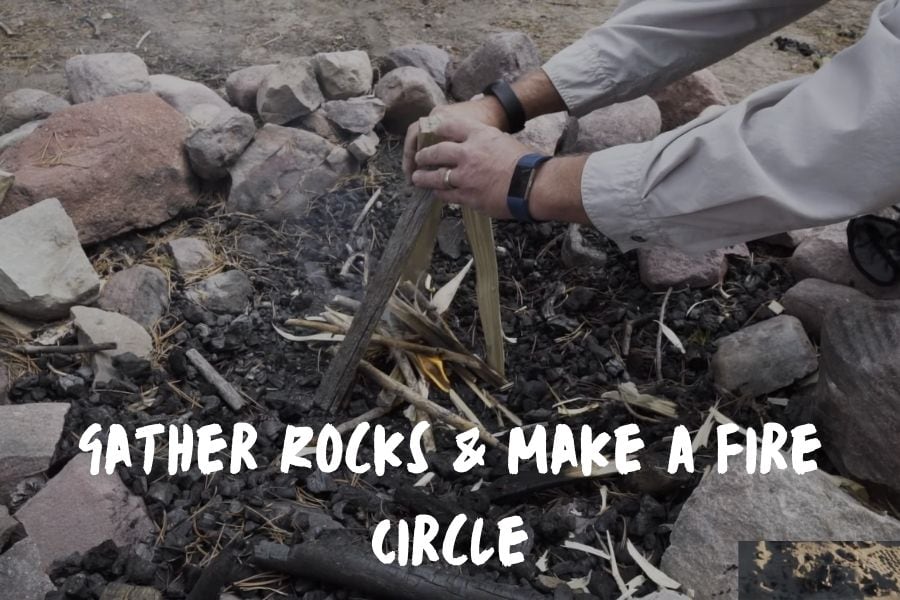
A hole itself is not good enough for a windshield. You can make it bigger by putting rocks around it.
Depending on what kind of beach it is, rocks may be easier or harder to find.
If you’re camping on a sandy beach, consider bringing some rocks from home. (Just don’t leave them behind!)
Add Some Small Logs & A Lot Of Kindling

The most popular way of building fire is by placing kindling and logs into a cone.
However, a log cabin style is a much better option as it stands well against the wind.
To build this fire, lay down kindling at the center, crisscrossed in a log cabin design.
Then, lay two larger logs parallel to each other. Do this on both sides of the pile of kindling you just created.
Then, do the same with more logs, but in the opposite direction.
Do this a few times, and you have a log cabin fire!
Also See: Bonfire vs. Campfire
Use A Long-Reach Lighter

Since kindling is in the middle, reaching it can be pretty difficult with a regular lighter.
That’s why you should bring a long-reach lighter to light a fire while keeping your hands at a safe distance.
Wait A Few Minutes
Once the kindling is lit, it will take a few minutes before the flames are spread onto the logs.
So, if the fire doesn’t get huge right away, don’t panic and start beating around with a lighter in your hands.
FAQs
What Are Fun Things To Do While Beach Camping?
There are many fun water activities you can enjoy at the beach. Swimming and snorkeling are obvious ones.
But depending on the location and the amenities available, you can also go kayaking, water skiing, or boating.
Is It Okay To Take A Tent To The Beach?
Of course, as long as the beach allows setting up a tent.
Camping is prohibited on many private and state-owned beaches, while some might require you to obtain a permit first.
What Should You Avoid When Beach Camping?
Avoid setting up a camp too close to the beach.
Both the tide and waves can get your camp wet and even wash your stuff out to sea.
Can You Sleep In A Tent On The Beach?
As long as it’s permitted, yes. In fact, if you’re sleeping on a beach, it’s best to have shelter over your head.
Not only will you avoid insects, but nights can get cold and breezy, so a tent will keep you warm.
What Color Tent Is Best For The Beach?
Dark-colored tents can block UV radiation but will make your tent quite hot.
A white tent would do the opposite, but make sure the model has additional UV protection.
However, light blue or green colored beach tents make a calming atmosphere.
If you plan on spending some time inside the tent during the, then these colors might be a good option.
To Sum Things Up
Camping on a beach can be a wonderful experience.
But just because you have experience camping in a forest, doesn’t mean you’re necessarily ready to go beach camping.
If you do your research and prepare for the nuances of beach environments (wind, wetness, sand in bad places, etc.), then you will be able to fully enjoy the wonders and beauty of camping on the beach.
Hopefully, our beach camping tips can help you on your next adventure!
More


